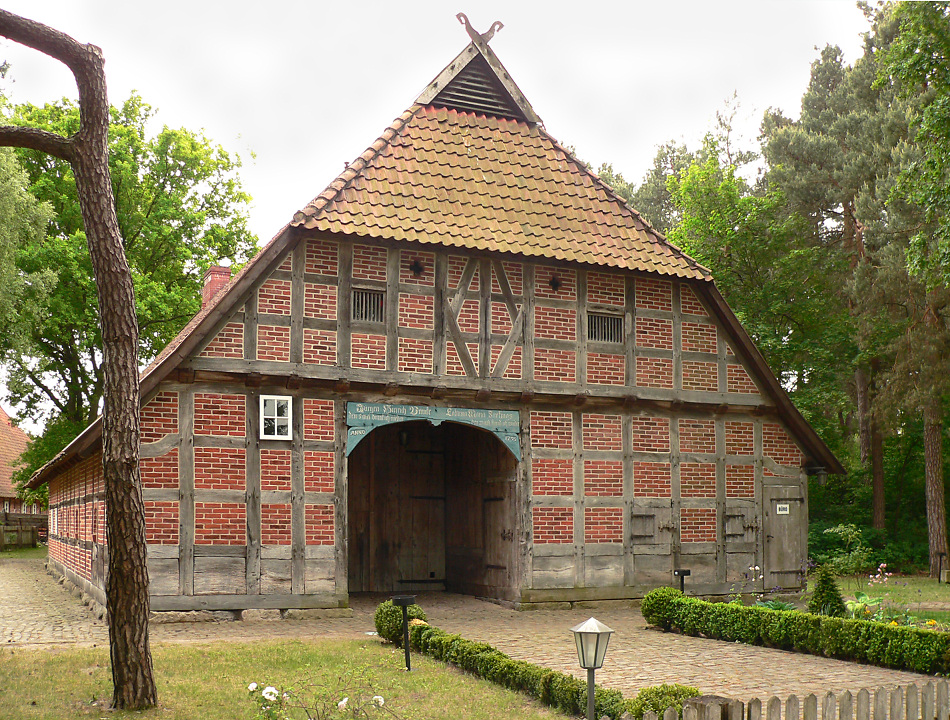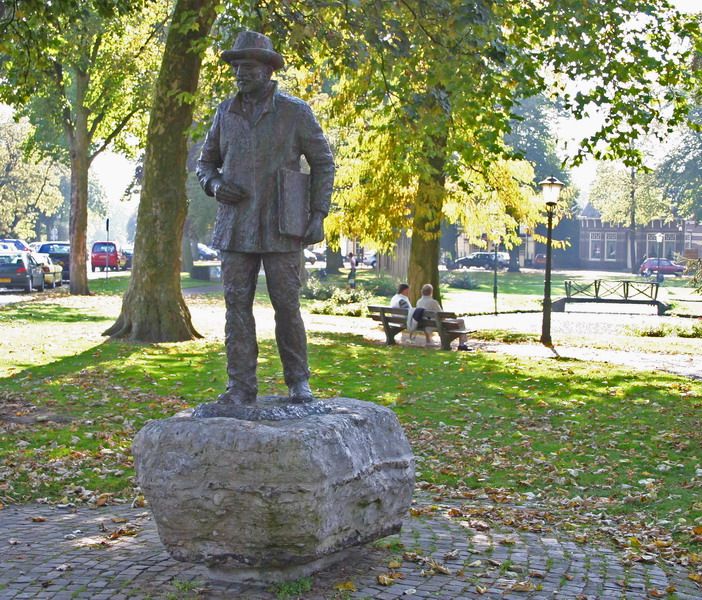|
Low Saxon House
The Low German house or ''Fachhallenhaus'' is a type of timber-framed farmhouse found in northern Germany and the easternmost Netherlands, which combines living quarters, byre and barn under one roof. It is built as a large hall with bays on the sides for livestock and storage and with the living accommodation at one end. The Low German house appeared during the 13th to 15th centuries and was referred to as the Low Saxon house (''Niedersachsenhaus'') in early research works. Until its decline in the 19th century, this rural, agricultural farmhouse style was widely distributed through the North German Plain, all the way from the Lower Rhine to Mecklenburg. Even today, the ''Fachhallenhaus'' still characterises the appearance of many north German villages. Name The German name, ''Fachhallenhaus'', is a regional variation of the term ''Hallenhaus'' ("hall house", sometimes qualified as the "Low Saxon hall house"). In the academic definition of this type of house the word ''Fac ... [...More Info...] [...Related Items...] OR: [Wikipedia] [Google] [Baidu] |
North Brabant
North Brabant ( ; ), also unofficially called Brabant, Dutch Brabant or Hollandic Brabant, is a province in the south of the Netherlands. It borders the provinces of South Holland and Gelderland to the north, Limburg to the east, Zeeland to the west, and the Flemish provinces of Antwerp and Limburg to the south. The northern border follows the Meuse westward to its mouth in the Hollands Diep strait, part of the Rhine–Meuse–Scheldt delta. North Brabant had a population of about 2,626,000 as of January 2023. Major cities in North Brabant are Eindhoven (pop. 231,642), Tilburg (pop. 217,259), Breda (pop. 183,873), its provincial capital 's-Hertogenbosch (pop. 154,205), and Helmond (pop. 94,967) History The Duchy of Brabant was a state of the Holy Roman Empire established in 1183 or 1190. It developed from the Landgraviate of Brabant and formed the heart of the historic Low Countries, part of the Burgundian Netherlands from 1430 and of the Habsburg Netherlands f ... [...More Info...] [...Related Items...] OR: [Wikipedia] [Google] [Baidu] |
Eider River
The Eider ( ; ; Latin: ''Egdor'' or ''Eidora'') is the longest river in the German state of Schleswig-Holstein. The river starts near Bordesholm and reaches the southwestern outskirts of Kiel on the shores of the Baltic Sea, but flows to the west, ending in the North Sea. The lower part of the Eider was used as part of the Eider Canal until that canal was replaced by the modern Kiel Canal. In the Early Middle Ages the river is believed to have been the border between the related Germanic tribes, the Jutes and the Angles, who along with the neighboring Saxons crossed the North Sea from this region during this period and settled in England. During the High Middle Ages the Eider was the border between the Saxons and the Danes, as reported by Adam of Bremen in 1076. For centuries it divided Denmark and the Holy Roman Empire. Today it is the border between Schleswig, Holstein and Eiderland, the northern and southern parts, respectively, of the modern German state of Schleswi ... [...More Info...] [...Related Items...] OR: [Wikipedia] [Google] [Baidu] |
Schleswig-Holstein
Schleswig-Holstein (; ; ; ; ; occasionally in English ''Sleswick-Holsatia'') is the Northern Germany, northernmost of the 16 states of Germany, comprising most of the historical Duchy of Holstein and the southern part of the former Duchy of Schleswig. Its capital city is Kiel; other notable cities are Lübeck and Flensburg. It covers an area of , making it the 5th smallest German federal state by area (including the city-states). Historically, the name can also refer to a larger region, containing both present-day Schleswig-Holstein and the former South Jutland County (Northern Schleswig; now part of the Region of Southern Denmark) in Denmark. Schleswig, named South Jutland at the time, was under Danish control during the Viking Age, but in the 12th century it became a duchy within Denmark due to infighting in the Danish Royal House. It bordered Holstein, which was a part of the Holy Roman Empire. Beginning in 1460, the King of Denmark ruled both Schleswig and Holstein as the ... [...More Info...] [...Related Items...] OR: [Wikipedia] [Google] [Baidu] |
Manor House
A manor house was historically the main residence of the lord of the manor. The house formed the administrative centre of a manor in the European feudal system; within its great hall were usually held the lord's manorial courts, communal meals with manorial tenants and great banquets. The term is today loosely (though erroneously) applied to various English country houses, mostly at the smaller end of the spectrum, sometimes dating from the Late Middle Ages, which currently or formerly house the landed gentry. Manor houses were sometimes fortified, albeit not as fortified as castles, but this was often more for show than for defence. They existed in most European countries where feudalism was present. Function The lord of the manor may have held several properties within a county or, for example in the case of a feudal baron, spread across a kingdom, which he occupied only on occasional visits. Even so, the business of the manor was directed and controlled by regular mano ... [...More Info...] [...Related Items...] OR: [Wikipedia] [Google] [Baidu] |
Netherlands
, Terminology of the Low Countries, informally Holland, is a country in Northwestern Europe, with Caribbean Netherlands, overseas territories in the Caribbean. It is the largest of the four constituent countries of the Kingdom of the Netherlands. The Netherlands consists of Provinces of the Netherlands, twelve provinces; it borders Germany to the east and Belgium to the south, with a North Sea coastline to the north and west. It shares Maritime boundary, maritime borders with the United Kingdom, Germany, and Belgium. The official language is Dutch language, Dutch, with West Frisian language, West Frisian as a secondary official language in the province of Friesland. Dutch, English_language, English, and Papiamento are official in the Caribbean Netherlands, Caribbean territories. The people who are from the Netherlands is often referred to as Dutch people, Dutch Ethnicity, Ethnicity group, not to be confused by the language. ''Netherlands'' literally means "lower countries" i ... [...More Info...] [...Related Items...] OR: [Wikipedia] [Google] [Baidu] |
Rafter
A rafter is one of a series of sloped structural members such as Beam (structure), steel beams that extend from the ridge or hip to the wall plate, downslope perimeter or eave, and that are designed to support the roof Roof shingle, shingles, roof deck, roof covering and its associated loads. A pair of rafters is called a ''couple''. In home construction, rafters are normally made of wood. Exposed rafters are a feature of some traditional roof styles. Applications In recent buildings there is a preference for trussed rafters on the grounds of cost, economy of materials, off-site manufacture, and ease of construction, as well as design considerations including span limitations and roof loads (weight from above). Types in traditional timber framing There are many names for rafters depending on their location, shape, or size (see below). The earliest surviving roofs in Europe are of common rafters on a tie beam; this assembly is known as a "closed couple". Later, principal raf ... [...More Info...] [...Related Items...] OR: [Wikipedia] [Google] [Baidu] |
Early Middle Ages
The Early Middle Ages (or early medieval period), sometimes controversially referred to as the Dark Ages (historiography), Dark Ages, is typically regarded by historians as lasting from the late 5th to the 10th century. They marked the start of the Middle Ages of History of Europe, European history, following the decline of the Roman Empire, decline of the Western Roman Empire, and preceding the High Middle Ages ( 11th to 14th centuries). The alternative term ''Late antiquity#Terminology, late antiquity'', for the early part of the period, emphasizes elements of continuity with the Roman Empire, while ''Early Middle Ages'' is used to emphasize developments characteristic of the earlier medieval period. The period saw a continuation of trends evident since late classical antiquity, including population decline, especially in urban centres, a decline of trade, Medieval Warm Period, a small rise in average temperatures in the North Atlantic region and Migration Period, increased m ... [...More Info...] [...Related Items...] OR: [Wikipedia] [Google] [Baidu] |
Byre-dwelling
A byre-dwelling ("byre"+ "dwelling") is a farmhouse in which the living quarters are combined with the livestock and/or grain barn under the same roof. In the latter case, the building is also called a housebarn in American English. This kind of construction is found in archaeological sites in northwestern Europe from the Bronze Age. It was also used in more modern times by Mennonites, originating from the Netherlands. Distribution Austria The Bregenzerwälderhaus from the Bregenz Forest in Vorarlberg is an example for a byre-dwelling. The stable and the usually two-storey house are under one roof. Germany The generic German term is ''Wohnstallhaus'' from ''Wohnung'' ("dwelling"), ''Stall'' ("byre", "sty)" and ''Haus'' ("house"). From the Iron Age onwards the longhouse, developed from the byre-dwellings of the Bronze Age with its domestic area and adjacent cattle bays, was found across the North German Plain. As a result of the keeping of ever larger herds of cattle, ... [...More Info...] [...Related Items...] OR: [Wikipedia] [Google] [Baidu] |
Cologne
Cologne ( ; ; ) is the largest city of the States of Germany, German state of North Rhine-Westphalia and the List of cities in Germany by population, fourth-most populous city of Germany with nearly 1.1 million inhabitants in the city proper and over 3.1 million people in the Cologne Bonn Region, Cologne Bonn urban region. Cologne is also part of the Rhine-Ruhr metropolitan region, the List of EU metropolitan regions by GDP#2021 ranking of top four German metropolitan regions, second biggest metropolitan region by GDP in the European Union. Centered on the left bank of the Rhine, left (west) bank of the Rhine, Cologne is located on the River Rhine (Lower Rhine), about southeast of the North Rhine-Westphalia state capital Düsseldorf and northwest of Bonn, the former capital of West Germany. The city's medieval Cologne Cathedral () was the History of the world's tallest buildings#Churches and cathedrals: Tallest buildings between the 13th and 20th century, world's talles ... [...More Info...] [...Related Items...] OR: [Wikipedia] [Google] [Baidu] |








